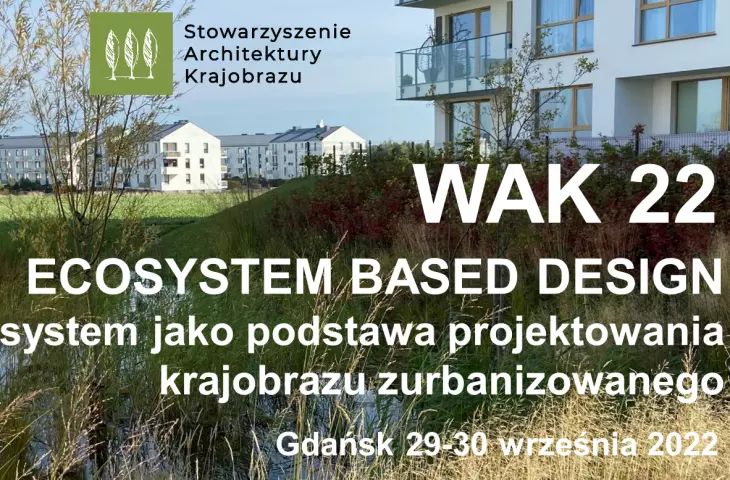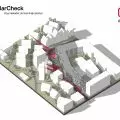The WAK2022 conference organized by the Landscape Architecture Association is fast approaching. What topics will be discussed at the conference and who will be there? We talk about the association and the conference with SAK president Joanna Rayss.
Wiktor Bochenek: The Society of Landscape Architects is not as well-known an institution as SARP. If you were to explain what SAK is, and what it does?
Joanna Rayss (President of the Society of Landscape Architects): Actually, the recognition of both landscape architecture professionals themselves and organizations associated with our industry is much lower than that of SARP, for example.
This is primarily because our profession is much younger, and the professional status itself is still unregulated. Hence the lower demand and popularity of our services, the chaos in the quality of education and the obligation to hire a professional greenery designer or a reputable contractor is the goodwill of the investor, which translates into a large discrepancy in the quality of services provided in our industry.
For these reasons, it is our Association that patronizes the entire, broad industry related to landscape architecture and, unlike, for example, the SARP, we deliberately do not narrow our membership to designers - landscape architects alone, expanding it to include professionals from related industries.
Our offer of cooperation is addressed primarily to practicing designers and contractors, but among our members you will also find scientists, officials, but also students - who join us on other terms.
Wiktor: What is the mission of SAK?
Joanna: The basis of the association's activities is the personal, unpaid commitment of our members to not only promote and protect our profession, normalize the rights to its activities, but above all to improve the quality of the landscape in the broadest sense, the sustainable development of the country and its regions, the promotion of new technologies in the industry, the development of good practices and standards in the implementation of scientific studies, projects and execution of landscape architecture objects.
As part of our mission, we also promote the idea of developing and properly caring for legally protected areas such as national, scenic and cultural parks, as well as the development and implementation of the concept of green infrastructure as critical infrastructure.
To this end, we undertake cooperation within the framework of partnership agreements with the entire professional landscape community. We cooperate with such organizations as, among others, the Federation of Polish Arborists, the Polish Dendrological Society, the National Association of Garden Designers, the Eco-Development Foundation or the Association of Polish Nurserymen, but also with the aforementioned Association of Polish Architects, PLGBC, or the Society of Polish Urban Planners and many others.
We are keen for the Association to be inclusive, not exclusive, which we take for granted insofar as the landscape itself combines the need for all industries to work together.
It is also worth emphasizing at this point how crucial is the role of integrating the entire architectural industry in the effort to regulate the status of our profession. The lack of regulation of the profession and the lack of industry authorizations is not only a matter of comfort for the designer himself. Powers are followed by regulated and unified competence and formal requirements for branch solutions, professional responsibility and their clear division.
Joanna Rayss
© Joanna Rayss
We end up with an absurd situation where landscape architecture objects, such as a park, cemetery or square, must be designed by architects in our country, because only they can sign off on them with their authorizations. Hardly, it can be done sooner by a road designer than by me with ecological, phytosociological, hydrological and compositional knowledge....
We need a dedicated branch authorization related to landscape architecture design, similar to that of electrical, road or sanitary designers. This is all the more necessary and urgent in a world changing due to climate catastrophe. It is the qualified landscape architect with skills in the field of ecological engineering who is the specialist who knows how to adapt cities to climate change, using green infrastructure and its ecosystem services.
Wiktor: Aside from legislative issues, what activities as president of SAK do you consider most important?
Joanna: As a person aware of my skills and limitations, I know that one of my greatest talents is the ability to see connections and connections that are not necessarily obvious. That's why I know that the most important step both in changing the legal area at the national level and in actually changing the space of our cities is to increase the competence of our industry in the area of ecological engineering in the broadest sense.
Only professionalism in the area of the quality of our industry's services can translate into our greater relevance and appreciation needed for legal and legislative change. And only we ourselves can bring this about. That's why it's so important to integrate and collaborate as an industry, to personally involve our members, to work closely with our environment, not just, for example, to retrain or create standards, which of course we do. The need for joint projects based on industry innovations, pilot activities, cooperation with schools and universities, because that' s where our future lies.
As chairwoman, with the support of the entire board of directors, I am additionally engaged in closer cooperation with institutions at the state and local government levels precisely to develop such innovative projects.
For example, in connection with the Green Deal being implemented throughout the Union. There are many indications that new EU financial subsidies will eventually reevaluate the way we look at investments in the direction of promoting green infrastructure. That's why we need to react quickly to changes in the world and the challenges accompanying climate change, and lobby for good solutions. As a trade association, we can do more than lone specialists.
It is worth mentioning here that, as SAK, we are also members of international institutions such as the International Federation of Landscape Architecture (IFLA Europe and IFLA World) and the European Landscape Contractors Association (ELCA). As part of these associations, we are also involved in achieving our goals at both the European and global levels.
An example of greenery designed by the Joanna Rayss team
© Rayss Group
Victor: Now let's move on to the upcoming event organized by SAK, the WAK2022 conference. What topics will be discussed at it and who will attend?
Joanna: WAK , which is SAK's annual flagship conference: Contemporary Landscape Architecture, is a conference where, true to its name, we want to introduce the most current trends, methods, challenges and problems related to our industry, as well as the directions of its development.
This year's edition is dedicated to the ecosystem as the basis of not only design, i.e. Ecosystem Based Design, but also the basis of the existence of life on our planet, which is actually forgotten. Ecosystem as the basis of design/design, is a context, on the one hand, broader than the recently very popular Nature based Solutions (NBS), on the other hand, thanks to such a definition, we avoid impersonating nature with solutions that are far from ecology, but try to convince us of their "naturalness".
EBD is distinguished from NBS primarily by the need to use ecosystem functionality and actually provide ecological services. Such ecosystem functionality will not exist without a specific set of natural elements and their connection to each other in the form of trophic networks and flows of energy and elements, as opposed, for example, to seepage boxes promoted as NBS, green walls dressed in plastic disposable pots or gravel roofs.
The source of the fact that we sometimes catch on to such balancing greenwashing solutions is our ignorance of natural processes and treating them in isolation in our cultural and educational space. Since elementary school, we have divided the ecosystem-forming biocenosis and biotope into biology and geography. This dichotomy is repenting in our space at every turn, becoming apparent in the promotion of solutions like stone mulch, agro-textile mulching, in our hatred of moles, wild boars and other soil animals, in the persistent "extermination of weeds" and glorification of the drained " perfectlawn," in the lack of awareness of the role of mosses, fungi or insects in our environment, etc.
Of course, at the conference we will also address the issue of carbon sequestration by ecosystems in urban spaces. In my opinion, this is the most underestimated ecosystem tool and service in the context of the fight against climate change, and it is impossible to talk about zero-carbon cities without looking for solutions that favor the mitigation of these changes and the reduction of carbon compounds in the atmosphere. We won't do this by only focusing on reducing emissions.
It is also impossible to ignore the fact of the ongoing war across our eastern border. That is why, in addition to domestic experts and those from northwestern directions, such as Scandinavian countries and the Netherlands, we have also invited our colleagues from Ukraine to our conference. These are President of the Lviv-based PLATO Foundation Mykola Riabyka, Head of the Lviv Bureau of Ecology and Natural Resources Oleksandra Sladkova and award-winning landscape designer from Kiev Anna Galagan.
In addition, I am proud that our invitation has also been accepted by: a fantastic landscape ecologist, associated, among others, with EarthWatch Victor Beumer, Mariusz Hermansdorfer, representing the Henning Larsen studio, previously associated for many years with Atelier Dreiseitl, or David Brasfield from Oslo, who has great experience in the implementation of biocenotic greenery on roofs.
Speakers from Poland will include Piotr and Daria Sikorski, fantastic scientists from the Warsaw University of Life Sciences (SGGW) researching the popularization of knowledge in the field of applied phytosociology. Piotr is in fact the co-author of the book "Applied Phytolossociology," which is, in my opinion, the most important textbook in the field of landscape architecture. Mr. and Mrs. Sikorsky will address the issue of "Using phytosociology and the succession process in landscape interventions based on the results of their own studies of ruderal communities and tramway tracks in Warsaw and Lodz."
Also coming to Gdansk will be Krzysztof Rostanski, a well-known specialist in naturalistic greenery design, Kasper Jakubowski, promoter of the fourth nature and president of the "Children into Nature" Foundation, president of the Landscapes Foundation - Wojciech Januszczyk, and Marcin Kubus from the Polish Dendrological Association, who will talk about the possibility of using the biotechnical properties of trees and shrubs, for example, as an alternative to the openwork panels beloved by many road builders in stabilizing slopes.
The conference will be concluded by a substantive discussion, in which, thanks to the moderator - Editor-in-Chief of Architecture and Business - Malgosia Tomczak, invited representatives of entities and organizations responsible for the implementation of possible "ecosystem" projects will consider possible barriers, opportunities and threats standing in the way of the ecosystem revolution in green infrastructure design and the possibility of promoting and financing such projects. Here, among Malgosia's guests, we will listen to urban planner and Head Architect of the City of Gdansk - Piotr Lorens, Director of the Department of Environment of the City of Gdansk Maciej Lorek, Maciej Milczynski - President of the Polish Nurserymen's Association, Oleksandra Sladkova, Head of the Board of Greenery in Lviv and Representative of the Ministry of Climate and Environment Piotr Czarnocki. SAK will be represented in this discussion by Kasia Kobierska. Importantly, the conference will be opened with me by Deputy Mayor of Gdansk Piotr Borawski.
Poster promoting WAK22
© Association of Landscape Architects
Wiktor: If you had to summarize why it is worthwhile to attend this conference.
Joanna: WAK2022 comprehensively addresses the most current and important trend related to the design of maintenance, transformation and regeneration of greenery in urban areas. At our conference, the ecosystem is not only an object, but also a subject of design. Knowledge will be presented in a condensed way, from design methods to implementation tools and their sources of funding. This is the most important substantive event - training in the green industry this year and a unique opportunity for our integration in the fantastic, inspiring space of the European Solidarity Center. Only through personal participation and behind-the-scenes exchange of experience and energy does real change become possible. That's why it's worth it to be in Gdansk, which I strongly encourage you to do, whether you are a green designer, architect, civil servant, contractor, student or "green activist" involved in the space around you. See you in Gdansk!
Wiktor: Thank you for the interview!























